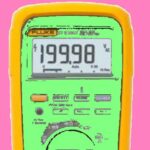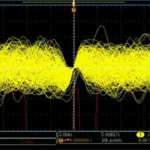Motors bridge electronics with electromechanical devices. To learn how to test motors and their electronics, you should first understand how motors work.
Electric motors are ubiquitous, appearing in everything from electric toothbrushes to electric locomotives. There are, however, seemingly almost as many motor types and configurations as there are applications, which makes choosing and testing the optimal model can be a chore. In part 1 of this series, we will consider two DC motor configurations.
How do motors work?
Consider a simplified traditional DC motor. DC motors typically have three to 12 poles, but for simplicity, Figure 1 shows a 2-pole version. In this example, the stator includes two field windings and brushes (usually carbon). The rotor contains armature windings and a commutator. The armature and field windings can operate on the same voltages (shunt motor) or even be connected in series (series motor), but power semiconductors make it easy to separately excite both sets of windings, providing advantages in precise control.


What’s the role of the commutator?
It delivers current to the armature windings (Figure 2) and consists of a conductor (usually copper) concentrically arranged on the rotor, from which it is insulated. A commutator has multiple conductive segments (two in this case) insulated from each other.
How do these parts work together?
Figure 3a shows a simplified version of Figure 1 with red arrows indicating current flow. The currents establish the magnetic polarities indicated, and the motor begins rotating clockwise (Figure 3b). The first commutation occurs shortly after the Figure 3b position when the positive brush disconnects from commutator segment 1 and comes in contact with commutator segment 2. At this point, the current direction switches, and so, too, do the magnetic polarities (Figure 3c), and the field south pole will repel the armature winding 1 south pole, continuing rotation in the clockwise direction. The process repeats, with two commutations occurring per each rotation, until powered off.

What are the disadvantages of conventional DC motors?
The brush-and-commutator combination adds resistance, thereby reducing efficiency, and is subject to mechanical wear. In addition, commutation involves the interruption of currents in the inductive armature windings, introducing electrical noise as well as the possibility of arcing and flashover. In Figure 2, you will note that the edges of the commutators’ conductive segments are chamfered to reduce voltage stress, but noise, resistance, and mechanical wear continue to be issues.
What’s an alternative?
The brushless DC (BLDC) motor is one. We can turn our Figure 1 simplified diagram into a BLDC diagram by removing the brushes and replacing the commutator and armature windings with a permanent magnet (Figure 4).

Wait, with the winding polarities penciled in, won’t the rotor just rotate clockwise 90° and stop?
Indeed. Without brushes and mechanical commutator, we must add an electronic commutation scheme such as the one shown in Figure 5. Turning on transistors Q2 and Q3 causes current to flow in the direction of the red arrows, establishing the magnetic polarities shown and initiating clockwise rotation. At the point where mechanical commutation would have occurred in Figure 3, we turn off Q2 and Q3 and turn on Q1 and Q4, reversing the current and the magnetic polarities. The motor in Figure 5 includes a Hall-effect sensor to provide feedback to the electronics for precise control.

This looks like an AC motor with an inverter in front of it, doesn’t it
Interesting observation. If you remove the transistors and substitute an AC line as the input, you’ll have a simplified diagram of a synchronous permanent-magnet AC motor. Note that for the conventional DC motor in Figure 3, AC current flows in the armature windings with the commutator acting as the inverter. In one sense, every motor can be considered an AC motor.
What are the disadvantages of a BLDC motor?
In part 2 of this FAQ, we’ll examine some drawbacks of the BLDC motor, some additional motor types, and some specific motor parameters and how to measure them. Meanwhile, you can take a look at Motor Handbook, published by Infineon and written in conjunction with RWTH Aachen University, which describes in detail a variety of motor types and their advantages and disadvantages.
Related
How do I choose an electric motor, and how do I test it? Part 2
How do I choose an electric motor, and how do I test it? Part 3
How do I choose an electric motor, and how do I test it? Part 4
Driving brushed and brushless DC motors
Motor fundamentals and DC motors
Webinars: Motor Drives Design
The brushed DC motor: Still a very viable option, Part 1: Operation
The brushed DC motor: Still a very viable option, Part 2: Applications
The brushed DC motor: Still a very viable option, Part 3: Drivers
FAQ: What’s the difference between BLDC and synchronous AC motors?
Comparing stepper and brushless dc motors






Part 2 will be available on October 9.